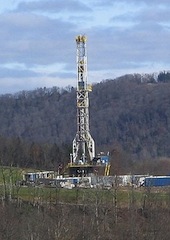Carried Away by the Shale Gale
Is the so-called shale boom in the United States just hype?
October 21, 2013

The United States is in the midst of a boom in energy production. Over the past five years, production has increased by over 25% and net oil imports are down 40%. All this has led to some euphoria.
“This shale gale, I describe it as the energy equivalent of the Berlin Wall coming down. This is a big deal,” says Robin West, chairman and CEO of PFC Energy. The American Enterprise Institute’s Carpe Diem blog claims “America’s shale energy revolution is taking us from resource scarcity to a new era of resource abundance.”
The boom does offer some reasons to rejoice. New technologies have been developed. A resource boom, properly managed, can be a source of wealth for many. And the boom has come at a time when the rest of the economy has been in poor straits.
Still, there are reasons not to get carried away:
1. The new supplies are not expected to last forever.
2. The impact on the overall U.S. economy will be rather modest.
3.The boom in U.S. energy production does not give this country a leg up over other nations — all trading partners gain when one country gets rich.
Limited supplies
The U.S. Energy Information Administration expects production of tight oil—petroleum found in formations of low permeability, generally shale or tight sandstone—to increase until 2020 but then start to fall off during the next two decades. U.S. shale gas production is expected to increase until about 2040.
But even after factoring in this additional production, the share of the energy sector in the U.S. economy remains very small, only about 1.5% of GDP.
Limited impact
The small energy share in turn implies that the impact of the boom on the overall U.S. economy is also modest. Results from the IMF’s Global Economy Model show that the additional production will raise U.S. incomes (as measured by real GDP) by about 1.2% at the end of 13 years and U.S. employment by 0.5%.
That roughly translates into an increase of 0.8 million jobs—each of these jobs is valuable but this is a small number in an economy with nonfarm employment of 155 million. The impacts are only a little bit greater when the economy exhibits slack, as is the case at present.
Results from the IMF’s model also show small impacts of the energy boom on the U.S. trade balance. For sure, the energy component of the trade balance will decline as U.S. imports of energy fall. But since part of the increase in U.S. incomes will be spent on (non-energy) imports, this will act as a strong offset.
Not a zero-sum game
The increase in (non-energy) imports as United States incomes rise is the reason why other countries do not stand to lose as a result of the U.S. energy boom.
Particular sectors in these countries, chemical firms for instance, might be put at some disadvantage, but this is offset by gains in other industries that import to the United States. The IMF’s results show small positive impacts on GDP levels in other country blocs (with the exception of a very small decrease in the GDP of other energy-exporting countries).
So let’s cherish the innovation and entrepreneurship and innovation that brought us the shale gale. But let’s not exaggerate its economic effects, nor turn a blind eye to its environmental risks.
Editor’s note: The views expressed are those of the author and should not be attributed to the IMF.
Takeaways
The new gas supplies are not expected to last forever -- and the impact on the overall US economy will be modest.
The boom in US gas production doesn’t help the US vs other economies. All trade partners gain when one gets richer.
Let’s not exaggerate shale’s economic effects, nor turn a blind eye to its environmental risks.
Read previous

The Double-Faced Digital Revolution
October 21, 2013
